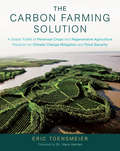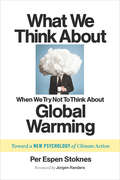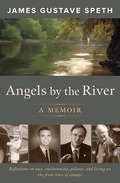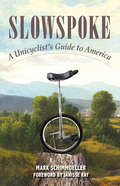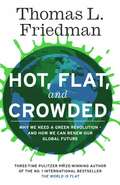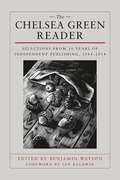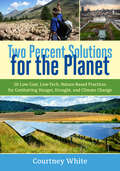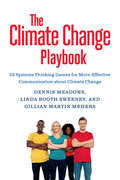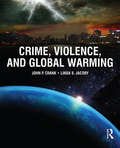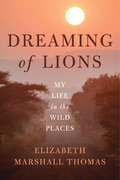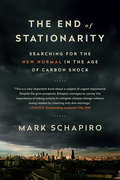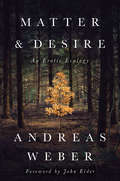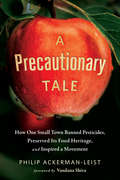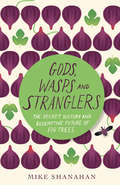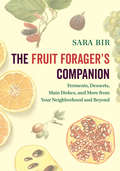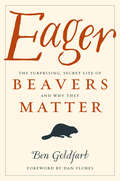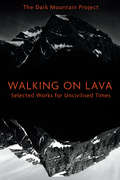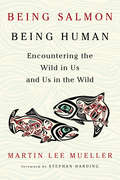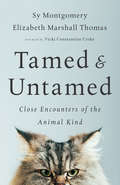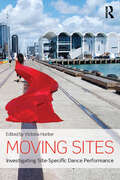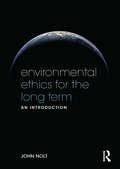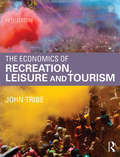- Table View
- List View
The Carbon Farming Solution: A Global Toolkit of Perennial Crops and Regenerative Agriculture Practices for Climate Change Mitigation and Food Security
by Eric Toensmeier Dr Hans HerrenWith carbon farming, agriculture ceases to be part of the climate problem and becomes a critical part of the solution Agriculture is rightly blamed as a major culprit of our climate crisis. But in this groundbreaking new book, Eric Toensmeier argues that agriculture—specifically, the subset of practices known as “carbon farming”—can, and should be, a linchpin of a global climate solutions platform. Carbon farming is a suite of agricultural practices and crops that sequester carbon in the soil and in above-ground biomass. Combined with a massive reduction in fossil fuel emissions—and in concert with adaptation strategies to our changing environment— carbon farming has the potential to bring us back from the brink of disaster and return our atmosphere to the “magic number” of 350 parts per million of carbon dioxide. Toensmeier’s book is the first to bring together these powerful strategies in one place, including in-depth analysis of the available research and, where research is lacking, a discussion of what it will take to get us there. Carbon farming can take many forms. The simplest practices involve modifications to annual crop production. Although many of these modifications have relatively low sequestration potential, they are widely applicable and easily adopted, and thus have excellent potential to mitigate climate change if practiced on a global scale. Likewise, grazing systems such as silvopasture are easily replicable, don’t require significant changes to human diet, and—given the amount of agricultural land worldwide that is devoted to pasture—can be important strategies in the carbon farming arsenal. But by far, agroforestry practices and perennial crops present the best opportunities for sequestration. While many of these systems are challenging to establish and manage, and would require us to change our diets to new and largely unfamiliar perennial crops, they also offer huge potential that has been almost entirely ignored by climate crusaders. Many of these carbon farming practices are already implemented globally on a scale of millions of hectares. These are not minor or marginal efforts, but win-win solutions that provide food, fodder, and feedstocks while fostering community self-reliance, creating jobs, protecting biodiversity, and repairing degraded land—all while sequestering carbon, reducing emissions, and ultimately contributing to a climate that will remain amenable to human civilization. Just as importantly to a livable future, these crops and practices can contribute to broader social goals such as women’s empowerment, food sovereignty, and climate justice. The Carbon Farming Solution does not present a prescription for how cropland should be used and is not, first and foremost, a how-to manual, although following up on references in a given section will frequently provide such information. Instead, The Carbon Farming Solution is—at its root—a toolkit. It is the most complete collection of climate-friendly crops and practices currently available. With this toolkit, farmers, communities, and governments large and small, can successfully launch carbon farming projects with the most appropriate crops and practices to their climate, locale, and socioeconomic needs. Toensmeier’s ultimate goal is to place carbon farming firmly in the center of the climate solutions platform, alongside clean solar and wind energy. With The Carbon Farming Solution, Toensmeier wants to change the discussion, impact policy decisions, and steer mitigation funds to the research, projects, and people around the world who envision a future where agriculture becomes the protagonist in this fraught, urgent, and unprecedented drama of our time. Citizens, farmers, and funders will be inspired to use the tools presented in this important new book to transform degraded lands around the world into productive carbon-storing landscapes.
What We Think About When We Try Not To Think About Global Warming: Toward a New Psychology of Climate Action
by Per Espen Stoknes Jorgen RandersWhy does knowing more mean believing—and doing—less? A prescription for change The more facts that pile up about global warming, the greater the resistance to them grows, making it harder to enact measures to reduce greenhouse gas emissions and prepare communities for the inevitable change ahead. It is a catch-22 that starts, says psychologist and economist Per Espen Stoknes, from an inadequate understanding of the way most humans think, act, and live in the world around them. With dozens of examples—from the private sector to government agencies—Stoknes shows how to retell the story of climate change and, at the same time, create positive, meaningful actions that can be supported even by deniers. In What We Think About When We Try Not To Think About Global Warming, Stoknes not only masterfully identifies the five main psychological barriers to climate action, but addresses them with five strategies for how to talk about global warming in a way that creates action and solutions, not further inaction and despair. These strategies work with, rather than against, human nature. They are social, positive, and simple—making climate-friendly behaviors easy and convenient. They are also story-based, to help add meaning and create community, and include the use of signals, or indicators, to gauge feedback and be constantly responsive. Whether you are working on the front lines of the climate issue, immersed in the science, trying to make policy or educate the public, or just an average person trying to make sense of the cognitive dissonance or grapple with frustration over this looming issue, What We Think About When We Try Not To Think About Global Warming moves beyond the psychological barriers that block progress and opens new doorways to social and personal transformation.
Angels by the River: A Memoir
by James Gustave SpethReflections on race, environment, politics, and living on the front lines of change In Angels by the River, James Gustave "Gus" Speth recounts his unlikely path from a southern boyhood through his years as one of the nation's most influential mainstream environmentalists and eventually to the system-changing activism that shapes his current work. Born and raised in an idyllic but racially divided town that later became the scene of South Carolina's horrific Orangeburg Massacre, Speth explores how the civil rights movement and the South's agrarian roots shaped his later work in the heyday of the environmental movement, when he founded two landmark environmental groups, fought for the nation's toughest environmental laws, spearheaded programs in the United Nations, advised the White House, and moved into a leading academic role as dean of Yale's prestigious School of Forestry and Environmental Studies. Yet, in the end, he arrived somewhere quite unexpected–still believing change is possible, but not within the current political and economic system. Throughout this compelling memoir, Speth intertwines three stories–his own, his hometown's, and his country's–focusing mainly on his early years and the lessons he drew from them, and his later years, in which he comes full circle in applying those lessons. In the process he invites others to join him politically at or near the place at which he has arrived, wherever they may have started.
Slowspoke: A Unicyclist's Guide to America
by Mark SchimmoellerWhy a unicycle? Why a cross-country trip? Why leave a prominent New York magazine and return to the simple life in Kentucky? Reminiscent of classic literary travelogues, Mark Schimmoeller’s Slowspoke: A Unicyclist’s Guide to America takes readers on an inward, emotional journey as he inches across landscapes and communities from North Carolina to Arizona. Schimmoeller became inspired by his unicycle as an adolescent. It taught him that rushing—whether down the driveway or toward adulthood—would cause a fall, and so, instead of accepting the speeding, straight line that de-fines modern American life, he adopted his single wheel’s wayward rhythms. Written with poise and humor, Slowspoke is more than a cross-country trip on a unicycle; it’s a meditation on a playful, recalcitrant slowness that is increasingly rare in a culture obsessed with acceleration. At times ach-ing and other times joyful, Schimmoeller intersperses recollections of his journey with vignettes of his present-day, off-the-grid homesteading with his wife in Kentucky and their efforts to save an old-growth forest. Schimmoeller’s personal journey will resonate with anyone who has slowed down to experience life at a unicycle’s speed or who longs to do so, who has fallen in love or searched for it, or who has treasured tall trees or mourned their loss.
Hot, Flat, and Crowded: Why The World Needs A Green Revolution - and How We Can Renew Our Global Future
by Thomas L. FriedmanThomas L. Friedman's phenomenal number-one bestseller The World is Flat has helped millions of readers see the world in a new way. In this essential new book, Friedman takes a fresh and provocative look at two of the biggest challenges we face today: the global environmental crisis and America's surprising loss of focus and national purpose since 9/11. It is a groundbreaking account of where we stand now, and he shows us how the solutions to these two big problems are linked - how we can restore the world and revive America at the same time. Friedman explains how global warming, rapidly growing populations, and the astonishing expansion of the world's middle class through globalization have produced a planet that is 'hot, flat, and crowded'. In just a few years, it will be too late to fix things - unless there is a worldwide effort to replace our wasteful, inefficient energy practices with a strategy for clean energy, energy efficiency, and conservation that Friedman calls Code Green. This is a great challenge, Friedman explains, but also a great opportunity, and one that we cannot afford to miss. He argues that this cannot happen without American commitment and leadership. In vivid, entertaining chapters, Friedman makes it clear that the green revolution we need is like no revolution the world has seen. It will be the biggest innovation project in history; it will be hard, not easy; and it will change everything, from what you put into your car to what you see on your electric bill. But the payoff will be more than just cleaner air. It will inspire us to summon all the intelligence, creativity, boldness and concern for the common good that are our greatest human resources.Hot, Flat, and Crowded is classic Thomas L. Friedman: fearless, incisive, forward-looking, and rich in surprising common sense about the challenge - and the promise - of the future.
The Chelsea Green Reader: Selections from 30 Years of Independent Publishing, 1984-2014
by Ben Watson Ian BaldwinChelsea Green, the Vermont-based independent publisher, has always had a nose for authors and subjects that are way ahead of the cultural curve, as is evident in this new anthology celebrating the company’s first thirty years in publishing. The more than one hundred books represented in this collection reflect the many distinct areas in which we have published–from literature and memoirs to progressive politics, to highly practical books on green building, organic gardening and farming, food and health, and related subjects–all of which reflect our underlying philosophy: "The politics and practice of sustainable living." The Chelsea Green Reader offers a glimpse into our wide-ranging list of books and authors and to the important ideas that they express. Interesting and worth reading in their own right, the individual passages when taken as a whole trace the evolution of a highly successful small publisher–something that is almost an oxymoron in these days of corporate buyouts and multinational book groups. From the beginning, Chelsea Green's books were nationally recognized, garnering positive reviews, accolades, and awards. We’ve published four New York Times bestsellers, and our books have set the standard for in-depth, how-to books that remain relevant years–often decades–beyond their original publication date. "Chelsea Green was born from a single seed: the beauty of craft. Craft in writing and editing, in a story well told, or a thesis superbly expressed," writes cofounder and publisher emeritus Ian Baldwin in the book's foreword. Today, craft continues to inform all aspects of our work–design, illustration, production, sales, promotion, and beyond. It has even informed our business model: In 2012, Chelsea Green became an employee-owned company. With the rise of the Internet, new media platforms, and a constantly shifting bookselling landscape, the future of publishing is anything but predictable. But if Chelsea Green's books prove anything, it is that, despite these challenges, there remains a hunger for new and important ideas and authors, and for the permanence and craftsmanship of the printed word. Today our ongoing mission is stronger than ever, as we launch into our next thirty years of publishing excellence.
Two Percent Solutions for the Planet: 50 Low-Cost, Low-Tech, Nature-Based Practices for Combatting Hunger, Drought, and Climate Change
by Courtney WhiteTwo Percent Solutions for the Planet profiles fifty innovative practices that soak up carbon dioxide in soils, reduce energy use, sustainably intensify food production, and increase water quality. The “two percent” refers to: the amount of new carbon in the soil needed to reap a wide variety of ecological and economic benefits; the percentage of the nation’s population who are farmers and ranchers; and the low financial cost (in terms of GDP) needed to get this work done. As White explained in Grass, Soil, Hope, a highly efficient carbon cycle captures, stores, releases, and recaptures biochemical energy, mitigating climate change, increasing water storage capacities in soil, and making green plants grow. Best of all, we don’t have to invent anything new—a wide variety of innovative ideas and methods that put carbon back into the soil have been field-tested and proven to be practical and profitable. They’re mostly low-tech, too, relying on natural resources such as sunlight, green plants, animals, compost, beavers, creeks, and more. In Two Percent Solutions for the Planet, White expands what he calls the “regenerative toolbox,” to include holistic grazing, edible forests, biochar, weed-eating livestock, food co-ops, keyline plowing, restoration agriculture, bioenergy, aquaponics, animal power, Farm Hack, bees, bears, wildlife corridors, rainwater harvesting, native seeds, and various other projects from across the United States, as well as in Canada, Europe, and Australia. These short, engaging success stories will help readers connect the dots between diverse, exciting, and pragmatic practices, and inspire them to dig deeper into each individual story and concept, energized by the news that solutions do exist.
The Climate Change Playbook: 22 Systems Thinking Games for More Effective Communication about Climate Change
by Dennis Meadows Linda Booth Sweeney Gillian Martin MehersAdvocates and teachers often find it difficult to communicate the complexities of climate change, because the people they are trying to reach hold so many mistaken assumptions. They assume, for example, that when climate change becomes an obvious threat to our everyday lives, there will still be time enough to make changes that will avoid disaster. Yet at that point it will be too late. Or they assume we can use our current paradigms and policy tools to find solutions. Yet the approaches that caused damage in the first place will cause even more damage in the future. Even the increasingly dire warnings from scientists haven’t shaken such assumptions. Is there another way to reach people? The simple, interactive exercises in The Climate Change Playbook can help citizens better understand climate change, diagnose its causes, anticipate its future consequences, and effect constructive change. Adapted from The Systems Thinking Playbook, the twenty-two games are now specifically relevant to climate-change communications and crafted for use by experts, advocates, and educators. Illustrated guidelines walk leaders through setting each game up, facilitating it, and debriefing participants. Users will find games that are suitable for a variety of audiences—whether large and seated, as in a conference room, or smaller and mobile, as in a workshop, seminar, or meeting. Designed by leading thinkers in systems, communications, and sustainability, the games focus on learning by doing.
Crime, Violence, and Global Warming
by John P. Crank Linda S. JacobyCrime, Violence, and Global Warming introduces the many connections between climate change and criminal activity. Conflict over natural resources can escalate to state and non-state actors, resulting in wars, asymmetrical warfare, and terrorism. Crank and Jacoby apply criminological theory to each aspect of this complicated web, helping readers to evaluate conflicting claims about global warming and to analyze evidence of the current and potential impact of climate change on conflict and crime. Beginning with an overview of the science of global warming, the authors move on to the links between climate change, scarce resources, and crime. Their approach takes in the full scope of causes and consequences, present and future, in the United States and throughout the world. The book concludes by looking ahead at the problem of forecasting future security implications if global warming continues or accelerates. This fresh approach to the criminology of climate change challenges readers to examine all sides of this controversial question and to formulate their own analysis of our planet’s future.
Crime, Violence, and Global Warming
by John P. Crank Linda S. JacobyCrime, Violence, and Global Warming introduces the many connections between climate change and criminal activity. Conflict over natural resources can escalate to state and non-state actors, resulting in wars, asymmetrical warfare, and terrorism. Crank and Jacoby apply criminological theory to each aspect of this complicated web, helping readers to evaluate conflicting claims about global warming and to analyze evidence of the current and potential impact of climate change on conflict and crime. Beginning with an overview of the science of global warming, the authors move on to the links between climate change, scarce resources, and crime. Their approach takes in the full scope of causes and consequences, present and future, in the United States and throughout the world. The book concludes by looking ahead at the problem of forecasting future security implications if global warming continues or accelerates. This fresh approach to the criminology of climate change challenges readers to examine all sides of this controversial question and to formulate their own analysis of our planet’s future.
Dreaming of Lions: My Life in the Wild Places
by Elizabeth Marshall ThomasElizabeth Marshall Thomas has spent a lifetime observing other creatures and other cultures, from her own backyard to the African savannah. Her books have transported millions of readers into the hidden lives of animals—from dogs and cats to deer and lions. She’s chronicled the daily lives of African tribes, and even imagined the lives of prehistoric humans. She illuminates unknown worlds like no other. Now, she opens the doors to her own. Dreaming of Lions traces Thomas’s life from her earliest days, including when, as a young woman in the 1950s, she and her family packed up and left for the Kalahari Desert to study the Ju/Wa Bushmen. The world’s understanding of African tribal cultures has never been the same since. Nor has Thomas, as the experience taught her not only how to observe, but also how to navigate in male-dominated fields like anthropology and animal science and do what she cared about most: spending time with animals and people in wild places, and relishing the people and animals around her at home. Readers join Thomas as she returns to Africa, after college and marriage, with her two young children, ending up in the turmoil leading to Idi Amin’s bloody coup. She invites us into her family life, her writing, and her fascination with animals—from elephants in Namibia, to dogs in her kitchen, or cougars outside her New England farmhouse. She also recounts her personal struggles, writing about her own life with the same kind of fierce honesty that she applies to the world around her, and delivering a memoir that not only shares tremendous insights, but also provides tremendous inspiration. Dreaming of Lions, originally published in hardcover as A Million Years With You, is slightly updated and includes a powerful new afterword by the author.
The End of Stationarity: Searching for the New Normal in the Age of Carbon Shock
by Mark SchapiroScientists have devised a new term to explain the turmoil caused by climate change: the end of stationarity. It means that our baselines for rainfall, water flow, temperature, and extreme weather are no longer relevant—that making predictions based on past experience is no longer possible. But climate change has upended baselines in the financial world, too, disrupting the global economy in ways that are just becoming clear, leaving us unable to assess risk, and causing us to fundamentally re-think economic priorities and existing business models. At the heart of that financial unrest is the role of carbon, and as the world moves toward making more and more polluters pay to emit it, a financial mystery unfolds: What are the costs? Who has the responsibility to pay for them? Who do you pay? How do you pay? And how will those costs ripple through the economy? These are the questions veteran journalist Mark Schapiro attempts to answer as he illuminates the struggle to pinpoint carbon's true costs and allocate them fairly--all while bumping up against the vagaries of the free market, the lobbying power of corporations, the political maneuverings of countries, and the tolerance of everyday consumers buying a cup of coffee, a tank of gas, or an airplane ticket. Along the way, Schapiro tracks the cost of carbon through the drought-ridden farmland of California, the jungles of Brazil, the world's greatest manufacturing center in China, the carbon-trading center of Europe, and the high-tech crime world that carbon markets have inspired. He even tracks the cost of carbon through the skies themselves, where efforts to put a price tag on the carbon left by airplanes in the no-man's land of the atmosphere created what amounted to a quiet but powerful global trade war. The End of Stationarity deftly depicts the wild, new carbon economy, and shows us how nations, emerging and developed, teeter on its brink. Originally published in hardcover as Carbon Shock, the book is updated throughout and includes a new afterword, based on the Paris climate talks.
Matter and Desire: An Erotic Ecology
by Dr Andreas Weber John ElderNautilus Award Gold Medal Winner, Ecology & Environment In Matter and Desire, internationally renowned biologist and philosopher Andreas Weber rewrites ecology as a tender practice of forging relationships, of yearning for connections, and of expressing these desires through our bodies. Being alive is an erotic process—constantly transforming the self through contact with others, desiring ever more life. In clever and surprising ways, Weber recognizes that love—the impulse to establish connections, to intermingle, to weave our existence poetically together with that of other beings—is a foundational principle of reality. The fact that we disregard this principle lies at the core of a global crisis of meaning that plays out in the avalanche of species loss and in our belief that the world is a dead mechanism controlled through economic efficiency. Although rooted in scientific observation, Matter and Desire becomes a tender philosophy for the Anthropocene, a “poetic materialism,” that closes the gap between mind and matter. Ultimately, Weber discovers, in order to save life on Earth—and our own meaningful existence as human beings—we must learn to love.
A Precautionary Tale: How One Small Town Banned Pesticides, Preserved Its Food Heritage, and Inspired a Movement
by Philip Ackerman-Leist Vandana ShivaMals, Italy, has long been known as the breadbasket of the Tyrol. But recently the tiny town became known for something else entirely. A Precautionary Tale tells us why, introducing readers to an unlikely group of activists and a forward-thinking mayor who came together to ban pesticides in Mals by a referendum vote—making it the first place on Earth to accomplish such a feat, and a model for other towns and regions to follow. For hundreds of years, the people of Mals had cherished their traditional foodways and kept their local agriculture organic. Their town had become a mecca for tourists drawn by the alpine landscape, the rural and historic character of the villages, and the fine breads, wines, cheeses, herbs, vegetables, and the other traditional foods they produced. Yet Mals is located high up in the eastern Alps, and the valley below was being steadily overtaken by big apple producers, heavily dependent on pesticides. As Big Apple crept further and further up the region’s mountainsides, their toxic spray drifted with the valley’s ever-present winds and began to fall on the farms and fields of Mals—threatening their organic certifications, as well as their health and that of their livestock. The advancing threats gradually motivated a diverse cast of characters to take action—each in their own unique way, and then in concert in an iconic display of direct democracy in action. As Ackerman-Leist recounts their uprising, we meet an organic dairy farmer who decides to speak up when his hay is poisoned by drift; a pediatrician who engaged other medical professionals to protect the soil, water, and air that the health of her patients depends upon; a hairdresser whose salon conversations mobilized the town’s women in an extraordinarily conceived campaign; and others who together orchestrated one of the rare revolutionary successes of our time and inspired a movement now snaking its way through Europe and the United States. A foreword by Vandana Shiva calls upon others to follow in Mals’s footsteps.
Gods, Wasps and Stranglers: The Secret History and Redemptive Future of Fig Trees
by Mike ShanahanOver millions of years, fig trees have shaped our world, influenced our evolution, nourished our bodies and fed our imaginations. And as author and ecologist Mike Shanahan proclaims, “The best could be yet to come.” Gods, Wasps and Stranglers weaves together the mythology, history and ecology of one of the world’s most fascinating—and diverse—groups of plants, from their starring role in every major religion to their potential to restore rainforests, halt the loss of rare and endangered species and even limit climate change. In this lively and joyous book, Shanahan recounts the epic journeys of tiny fig wasps, whose eighty-million-year-old relationship with fig trees has helped them sustain more species of birds and mammals than any other trees; the curious habits of fig-dependent rhinoceros hornbills; figs’ connection to Krishna and Buddha, Jesus and Muhammad; and even their importance to Kenya’s struggle for independence. Ultimately, Gods, Wasps and Stranglers is a story about humanity’s relationship with nature, one that is as relevant to our future as it is to our past.
The Fruit Forager's Companion: Ferments, Desserts, Main Dishes, and More from Your Neighborhood and Beyond
by Sara BirFrom apples and oranges to pawpaws and persimmons Half of the fruit that grows in yards and public spaces is never picked or eaten. Citrus trees are burdened with misshapen lemons, berries grow in tangled thickets on the roadside, and the crooked rows of abandoned orchards fill with fallen apples. At the same time, people yearn for an emotional connection that’s lacking in bland grocery store bananas and tasteless melons. The Fruit Forager’s Companion is a how-to guide with nearly 100 recipes devoted to the secret, sweet bounty just outside our front doors and ripe for the taking, from familiar apples and oranges to lesser-known pawpaws and mayhaws. Sara Bir—a seasoned chef, gardener, and forager—primes readers on foraging basics, demonstrates gathering and preservation techniques, and presents a suite of recipes including habanero crabapple jelly, lime pickle, pawpaw lemon curd, and fermented cranberry relish. Bir encourages readers to reconnect with nature and believes once the foraging mindset takes control, a new culinary world hiding in plain sight will reveal itself. Written in a witty and welcoming style, The Fruit Forager’s Companion is a must-have for seekers of both flavor and fun.
Eager: The Surprising, Secret Life of Beavers and Why They Matter
by Ben GoldfarbIn Eager, environmental journalist Ben Goldfarb reveals that our modern idea of what a healthy landscape looks like and how it functions is wrong, distorted by the fur trade that once trapped out millions of beavers from North America’s lakes and rivers. The consequences of losing beavers were profound: streams eroded, wetlands dried up, and species from salmon to swans lost vital habitat. Today, a growing coalition of “Beaver Believers”—including scientists, ranchers, and passionate citizens—recognizes that ecosystems with beavers are far healthier, for humans and non-humans alike, than those without them. From the Nevada deserts to the Scottish highlands, Believers are now hard at work restoring these industrious rodents to their former haunts. Eager is a powerful story about one of the world’s most influential species, how North America was colonized, how our landscapes have changed over the centuries, and how beavers can help us fight drought, flooding, wildfire, extinction, and the ravages of climate change. Ultimately, it’s about how we can learn to coexist, harmoniously and even beneficially, with our fellow travelers on this planet.
Walking on Lava: Selected Works for Uncivilised Times
by The Dark Mountain ProjectThe Dark Mountain Project began with a manifesto published in 2009 by two English writers—Dougald Hine and Paul Kingsnorth—who felt that literature was not responding honestly to the crises of our time. In a world in which the climate is being altered by human activities; in which global ecosystems are being destroyed by the advance of industrial civilisation; and in which the dominant economic and cultural assumptions of the West are visibly crumbling, Dark Mountain asked: where are the writers and the artists? Why are the mainstream cultural forms of our society still behaving as if this were the twentieth century—or even the nineteenth? Dark Mountain’s call for writers, thinkers and artists willing to face the depth of the mess we are in has made it a gathering point for a growing international network. Rooted in place, time and nature, their work finds a home in the pages of the Dark Mountain books, with two new volumes published every year. Walking on Lava brings together the best of the first ten volumes, along with the original manifesto. This collection of essays, fiction, poetry, interviews and artwork introduces The Dark Mountain Project’s groundbreaking work to a wider audience in search of ‘the hope beyond hope, the paths which lead to the unknown world ahead of us.’
Being Salmon, Being Human: Encountering the Wild in Us and Us in the Wild
by Stephan Harding Martin Lee MuellerNautilus Award Silver Medal Winner, Ecology & Environment In search of a new story for our place on earth Being Salmon, Being Human examines Western culture’s tragic alienation from nature by focusing on the relationship between people and salmon—weaving together key narratives about the Norwegian salmon industry as well as wild salmon in indigenous cultures of the Pacific Northwest. Mueller uses this lens to articulate a comprehensive critique of human exceptionalism, directly challenging the four-hundred-year-old notion that other animals are nothing but complicated machines without rich inner lives and that Earth is a passive backdrop to human experience. Being fully human, he argues, means experiencing the intersection of our horizon of understanding with that of other animals. Salmon are the test case for this. Mueller experiments, in evocative narrative passages, with imagining the world as a salmon might see it, and considering how this enriches our understanding of humanity in the process. Being Salmon, Being Human is both a philosophical and a narrative work, rewarding readers with insightful interpretations of major philosophers—Descartes, Heidegger, Abram, and many more—and reflections on the human–Earth relationship. It stands alongside Abram’s Spell of the Sensuous and Becoming Animal, as well as Andreas Weber’s The Biology of Wonder and Matter and Desire—heralding a new “Copernican revolution” in the fields of biology, ecology, and philosophy.
Tamed and Untamed: Close Encounters of the Animal Kind
by Elizabeth Marshall Thomas Sy Montgomery Vicki Constantine CrokeExtraordinary new insights into the minds and lives of our fellow creatures from two of the world’s top animal authors, Elizabeth Marshall Thomas and Sy Montgomery. A Mail on Sunday “Critic's Pick” Best Read of the Year "In their writing and in their lives and in their remarkable friendship, Liz and Sy break down false barriers and carry us closer to our fellow creatures.”—from the foreword by Vicki Constantine Croke, author of Elephant Company Tamed and Untamed―a collection of essays penned by two of the world's most celebrated animal writers, Sy Montgomery and Elizabeth Marshall Thomas―explores the minds, lives, and mysteries of animals as diverse as snails, house cats, hawks, sharks, dogs, lions, and even octopuses. Drawing on stories of animals both wild and domestic, the two authors, also best friends, created this book to put humans back into the animal world. The more we learn about what other animals think and do, they explain, the more we understand ourselves as animals, too. Writes Montgomery, “The list of attributes once thought to be unique to our species―from using tools to waging war―is not only rapidly shrinking, but starting to sound less and less impressive when we compare them with other animals’ powers.” With humor, empathy, and introspection, Montgomery and Thomas look into the lives of all kinds of creatures―from man’s best friend to the great white shark―and examine the ways we connect with our fellow species. Both authors have devoted their lives to sharing the animal kingdom’s magic with others, and their combined wisdom is an indispensable contribution to the field of animal literature. The book contains a foreword by Vicki Constantine Croke, author of the bestseller Elephant Company.
Moving Sites: Investigating Site-Specific Dance Performance
by Victoria HunterMoving Sites explores site-specific dance practice through a combination of analytical essays and practitioner accounts of their working processes. In offering this joint effort of theory and practice, it aims to provide dance academics, students and practitioners with a series of discussions that shed light both on approaches to making this type of dance practice, and evaluating and reflecting on it. The edited volume combines critical thinking from a range of perspectives including commentary and observation from the fields of dance studies, human geography and spatial theory in order to present interdisciplinary discourse and a range of critical and practice-led lenses through which this type of work can be considered and explored. In so doing, this book addresses the following questions: · How do choreographers make site-specific dance performance? · What occurs when a moving body engages with site, place and environment? · How might we interpret, analyse and evaluate this type of dance practice through a range of theoretical lenses? · How can this type of practice inform wider discussions of embodiment, site, space, place and environment? This innovative and exciting book seeks to move beyond description and discussion of site-specific dance as a spectacle or novelty and considers site-dance as a valid and vital form of contemporary dance practice that explores, reflects, disrupts, contests and develops understandings and practices of inhabiting and engaging with a range of sites and environments. Dr Victoria Hunter is Senior Lecturer in Dance at the University of Chichester.
Environmental Ethics for the Long Term: An Introduction
by John NoltBroad in scope, this introduction to environmental ethics considers both contemporary issues and the extent of humanity’s responsibility for distant future life. John Nolt, a logician and environmental ethicist, interweaves contemporary science, logical analysis, and ethical theory into the story of the expansion of ethics beyond the human species and into the far future. Informed by contemporary environmental science, the book deduces concrete policy recommendations from carefully justified ethical principles and ends with speculations concerning the deepest problems of environmental ethics. Pedagogical features include chapter outlines, annotated suggestions for further readings, the explanations of key terms when first mentioned, and an extensive glossary.
Environmental Ethics for the Long Term: An Introduction
by John NoltBroad in scope, this introduction to environmental ethics considers both contemporary issues and the extent of humanity’s responsibility for distant future life. John Nolt, a logician and environmental ethicist, interweaves contemporary science, logical analysis, and ethical theory into the story of the expansion of ethics beyond the human species and into the far future. Informed by contemporary environmental science, the book deduces concrete policy recommendations from carefully justified ethical principles and ends with speculations concerning the deepest problems of environmental ethics. Pedagogical features include chapter outlines, annotated suggestions for further readings, the explanations of key terms when first mentioned, and an extensive glossary.
The Economics of Recreation, Leisure and Tourism
by John TribeOne of the leading texts in the field, The Economics of Recreation, Leisure and Tourism is the ideal introduction to the fundamentals of economics in these industries, helping you to pass an economics module as part of tourism, recreation, events or sport management degrees. It is written in an engaging style that assumes no prior knowledge of economics. It applies economic theory to a range of tourism industry issues at the consumer, business, national and international level by using topical examples to give the theory real-world context. This book is richly illustrated with diagrams, and contains a range of features such as international case studies showcasing current issues, review questions and extracts from journals to aid understanding and further knowledge, as well as new data and statistics. This fifth edition has been revised and updated to include: New content on recent economic data, consumer choice looking at income–leisure decision approaches, growth areas of sports and events, environmental issues, the impact of the global economic crisis and what may happen in the future. Evidence is put forward to provide a sense of the dynamics of world economies. Updated and new international case studies throughout that demonstrate theoretical principles of economics as applied to tourism Updated companion website with PowerPoint slides
The Economics of Recreation, Leisure and Tourism
by John TribeOne of the leading texts in the field, The Economics of Recreation, Leisure and Tourism is the ideal introduction to the fundamentals of economics in these industries, helping you to pass an economics module as part of tourism, recreation, events or sport management degrees. It is written in an engaging style that assumes no prior knowledge of economics. It applies economic theory to a range of tourism industry issues at the consumer, business, national and international level by using topical examples to give the theory real-world context. This book is richly illustrated with diagrams, and contains a range of features such as international case studies showcasing current issues, review questions and extracts from journals to aid understanding and further knowledge, as well as new data and statistics. This fifth edition has been revised and updated to include: New content on recent economic data, consumer choice looking at income–leisure decision approaches, growth areas of sports and events, environmental issues, the impact of the global economic crisis and what may happen in the future. Evidence is put forward to provide a sense of the dynamics of world economies. Updated and new international case studies throughout that demonstrate theoretical principles of economics as applied to tourism Updated companion website with PowerPoint slides
